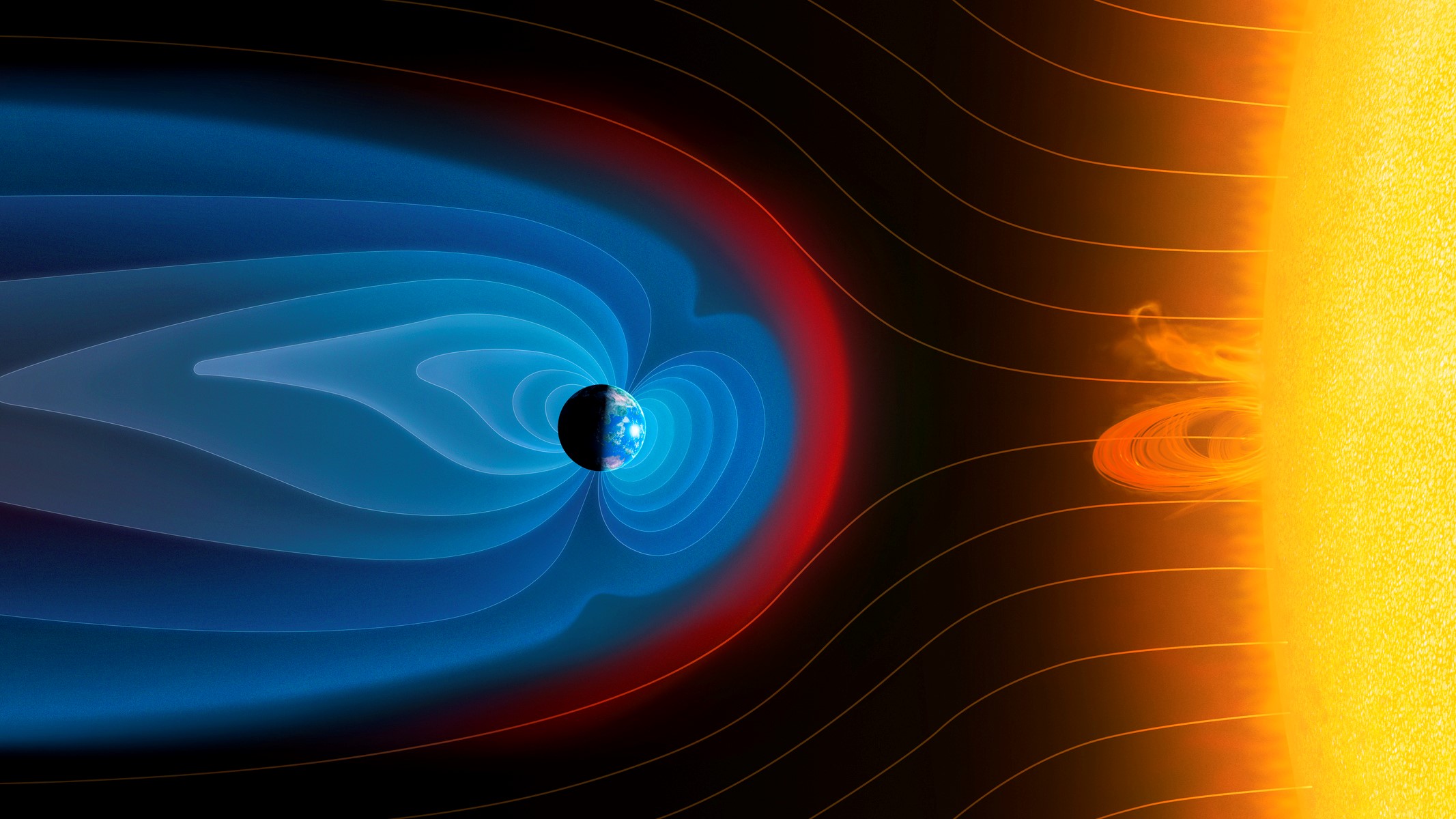Earth’s magnetic field — also known as the geomagnetic field — is generated in our planet’s interior and extends out into space, creating a region known as the magnetosphere.
Without the magnetic field, life on Earth as we know it would not be possible as it shields us all from the constant bombardment by charged particles emitted from the sun — the solar wind. (To learn what happens to a planet when it loses its magnetic field, you only need to look at Mars.)
Earth has two sets of poles, geographic pole and magnetic poles. Earth’s magnetic field can be visualized if you imagine a large bar magnet inside our planet, roughly aligned with Earth’s axis. Each end of the magnet lies relatively close (about 10 degrees) to the geographic North and South poles. Earth’s invisible magnetic field lines travel in a closed, continuous loop and are nearly vertical at each magnetic pole.
Related: The Carrington Event: History’s greatest solar storm
Geographic North and South poles are where lines of longitude converge according to GIS Geography (opens in new tab). The Geographic North Pole is located in the middle of the Arctic Ocean and the Geographic South Pole is found in Antarctica.
Magnetic poles are located where the magnetic lines of attraction enter Earth. The Magnetic North Pole is also known as the North Dip Pole and is currently found on Ellesmere Island in Northern Canada. When a magnetic compass points north it is aligning itself with Earth’s magnetic field and points to the Magnetic North Pole, not the Geographic North Pole, which is actually about 310 miles (500 kilometers) away according to GIS Geography!
(opens in new tab)
And just to make things that little more confusing, what we call the North Magnetic Pole is actually a south magnetic pole… bear with me on this. Magnetic field sources are dipolar, meaning they have a north and south pole. And when it comes to magnets, opposite poles (N and S) attract while other poles (N and N, S and S) repel. So when a compass points north, it is actually attracted to the south magnetic pole which lies close to the Geographic North Pole, according to Physicist Christopher Baird’s science FAQ website (opens in new tab) “Surprising Questions with Surprising Answers.”
Unlike the geographic poles, Earth’s magnetic poles are not fixed and tend to wander over time. British polar explorer James Clark Ross first identified the Magnetic North Pole on the Boothis Peninsula in Canada’s Nunavut territory in 1831, according to the Antarctic travel site Antarctic Logistics (opens in new tab). Since its discovery, the magnetic north pole moves about 25 miles (40 kilometers) a year in a northwest direction according to the Royal Museums Greenwich (opens in new tab). Whatsmore, Earth’s magnetic poles have also ‘flipped’ whereby north becomes south and south becomes north. These magnetic reversals occur at irregular intervals every 200,000 years or so.
What causes Earth’s magnetic field?
Earth’s magnetic field is generated by what is known as the geodynamo process. According to National Geographic (opens in new tab), for a planet to generate its own magnetic field by the geodynamo process, it must have the following characteristics:
- The planet rotates fast enough
- Its interior must have a fluid medium
- The interior fluid must have the ability to conduct electricity
- The core must have an internal source of energy that propels convection currents in the liquid interior.
The generation of Earth’s magnetic field occurs deep within the Earth’s interior, in a layer known as the outer core to be precise. Here the convective energy from the slow-moving molten iron is converted to electrical and magnetic energy, according to the U.S. Geological Survey (opens in new tab). The magnetic field then induces electric currents which in turn generate their own magnetic field which induces more electric currents, in a positive feedback loop.
How does the magnetic field protect Earth?

(opens in new tab)
Our protective magnetic “bubble,” known as the magnetosphere, protects us from harmful space weather such as solar wind. Without the magnetosphere, the solar wind would erode our atmosphere, devoiding our planet of the life-giving air we breathe.
According to NASA (opens in new tab), the magnetosphere also protects Earth from large quantities of particle radiation emitted during coronal mass ejection (CME) events and also from cosmic rays — atom fragments — raining down on Earth from deep space. The magnetosphere repels harmful energy away from Earth and traps it in zones called the Van Allen radiation belts. These donut-shaped belts of radiation can swell when the sun’s activity increases.
But our protective shield is not completely invincible.
During particularly strong space weather events such as high solar winds or large CMEs, Earth’s magnetic field is disturbed and geomagnetic storms can penetrate the magnetosphere and lead to widespread radio and power blackouts as well as endangering astronauts and Earth-orbiting satellites.
In 1859, a large solar storm known as the Carrington Event caused widespread telegraph system failures and in 1989, a CME accompanied a solar flare and plunged the entire province of Quebec, Canada into an electrical blackout that lasted around 12 hours according to a NASA statement (opens in new tab).
The degree of magnetic disturbance from a CME depends on the CME’s magnetic field and Earth’s. If the CME’s magnetic field is aligned with Earth’s, pointing from south to north the CME will pass on by with little effect. However, if the CME is aligned in the opposite direction it can cause Earth’s magnetic field to be reorganized, (opens in new tab) triggering large geomagnetic storms.
A less destructive and far prettier side effect of magnetosphere disturbances is the aurora above Earth’s polar regions. The phenomenon is known as the northern lights (aurora borealis) in the Northern Hemisphere and the southern lights (aurora australis) in the Southern Hemisphere.
The disturbances in Earth’s magnetic field funnel ions down towards Earth’s poles where they collide with atoms of oxygen and nitrogen in Earth’s atmosphere, creating dazzling aurora light shows.

(opens in new tab)
Magnetic pole reversal
According to Science Daily (opens in new tab), in the last 200 million years alone, Earth’s magnetic poles have reversed hundreds of times in a process where north becomes south and south becomes north.
The magnetic poles flip approximately every 200,000 to 300,000 years (opens in new tab) according to NASA, though it has been more than twice that long since the last reversal. Earth’s most recent magnetic reversal occurred approximately 790,000 years ago so we are rather overdue for another. But don’t worry, the magnetic poles won’t just switch overnight, it can take hundreds or even thousands of years for the poles to flip.
Magnetic fields on other planets
Earth is not the only planet in the solar system to possess a magnetic field. Jupiter, Saturn, Uranus and Neptune all exhibit magnetic fields far stronger than Earth’s, according to Union University (opens in new tab), though the underlying mechanisms driving these magnetic fields are not yet completely understood.
Not every planet is fortunate enough to have a protective magnetic layer. Mars does not have enough inner heat nor does it possess the liquid interior required to generate a magnetic field. Venus, on the other hand, has a liquid core but does not spin fast enough to generate a magnetic field.
Additional resources
If you want to read more about how scientists are investigating our planet’s interior and nearby space environment without even leaving the ground check out these resources (opens in new tab)from the U.S. Geological Survey. Learn more about Earth’s magnetic field with this short video from Arbor Scientific (opens in new tab). Explore magnetic and geographic poles in more detail with the Australian Antarctic Program (opens in new tab).
Bibliography
Baird, C. S. (November 15, 2013). Why does a magnetic compass point to the Geographic North Pole? Science Questions with Surprising Answers. Retrieved July 4, 2022, from www.wtamu.edu/~cbaird/sq/2013/11/15/why-does-a-magnetic-compass-point-to-the-geographic-north-pole/ (opens in new tab)
Buis, A. (August 3, 2021). Earth’s magnetosphere: Protecting our planet from harmful space energy – climate change: Vital signs of the planet. NASA. Retrieved July 4, 2022, from www.climate.nasa.gov/news/3105/earths-magnetosphere-protecting-our-planet-from-harmful-space-energy/ (opens in new tab)
Do other planets have magnetic fields like our Earth? Union University. Retrieved July 4, 2022, from www.uu.edu/dept/physics/scienceguys/2004Sept.cfm (opens in new tab)
Earths Interior. National Geographic Society. Retrieved July 4, 2022, from www.education.nationalgeographic.org/resource/core (opens in new tab)
Fox, K. C. (June 9, 2015). New tool could track space weather 24 hours before reaching Earth. NASA. Retrieved July 4, 2022, from www.nasa.gov/feature/goddard/new-tool-could-track-space-weather-24-hours-before-reaching-earth (opens in new tab)
Magnetic North vs Geographic (true) North Pole. GIS Geography. (May 27, 2022). Retrieved July 4, 2022, from www.gisgeography.com/magnetic-north-vs-geographic-true-pole/ (opens in new tab)
NASA. (November 30, 2011). 2012: Magnetic Pole Reversal happens all the (geologic) time. NASA. Retrieved July 4, 2022, from www.nasa.gov/topics/earth/features/2012-poleReversal.html (opens in new tab)
Odenqald, S. (March 13, 2009). The Day the sun brought darkness. NASA. Retrieved July 4, 2022, from https://www.nasa.gov/topics/earth/features/sun_darkness.html (opens in new tab)
RMG. John and James Clarke Ross North-West Passage expedition 1829–33. Royal Museums Greenwich. Retrieved July 4, 2022, from www.rmg.co.uk/stories/topics/john-james-clarke-ross-north-west-passage-expedition-1829-33 (opens in new tab)
ScienceDaily. (December 28, 2009). As the World Churns: Earth’s liquid outer core is slowly ‘stirred’ in a series of decades-long waves. ScienceDaily. Retrieved July 4, 2022, from www.sciencedaily.com/releases/2009/12/091223222743.htm (opens in new tab)
Sir James Clark Ross. Antarctic Logistics & Expeditions. Retrieved July 4, 2022, from www.antarctic-logistics.com/2010/08/28/sir-james-clark-ross/ (opens in new tab)
USGS. How does the Earth’s core generate a magnetic field? USGS. Retrieved July 4, 2022, from www.usgs.gov/faqs/how-does-earths-core-generate-magnetic-field (opens in new tab)

